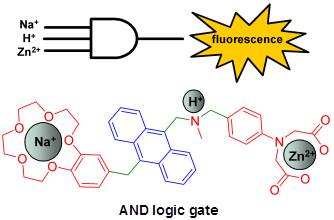Our research combines ideas from mathematics and computer science with chemistry to engineer intelligent molecules capable of performing calculations and information processing for medical and environmental applications. This involves synthesizing molecules with built-in logic operations according to Boolean algebraic functions (e.g. YES, NOT, OR, AND etc.). Just as individuals use these commands searching the internet for information, molecules can be designed to retrieve chemical information from a solution in a test tube. Molecules able to perform these logic functions, and many others, have been reported in the scientific literature. Even more fascinating, though, is that even more complex molecules integrating many of these elementary logic functions have been demonstrated that can, for example, add and subtract numbers, play tit-tat-toe against a human opponent and operate as a security keypad lock like that on an ATM machine, for example.

A long-term objective is to develop tailor-made molecules with built-in logic functions as ‘lab-on-a-molecule’ systems for screening specific disease conditions. Many diseases result in significant changes in the levels of various individual analytes. Often, several or even dozens of chemical tests have to be performed and the results analyzed by a practitioner before a diagnosis on a patient’s disease condition is made. Rather than performing a series of individual tests, what if we could develop intelligent molecules that in a single rapid test could identify many individual indicators simultaneously and give a diagnosis autonomously without the need of a doctor to analyze the results. It could potential revolutionize the field of biomedical diagnostic testing by improving the quality of healthcare by shortening diagnosis time while reducing the number of of tests needed and potentially reducing health care costs too.
The cornerstone principle of the research is based on the application of electron transfer theories to intramolecular photoinduced electron transfer and charge transfer phenomena within molecular systems using photochemical and electrochemical techniques. Relying on these foundations, the research involves the synthesis of the multi-analyte chemosensors, followed by evaluation of their chemical, electrochemical, and photophysical properties, and testing the molecules in order to demonstrate molecular information processing and computations. Eventually, the long-term goal is to demonstrate the real-life application of “lab-on-a molecule” systems by designing molecules that can provide insightful information on a blood or urine sample, or in the environment inside a living cell.
The Advent of "Lab-on-a-Molecule" Systems
The first molecular 3-input AND logic gate capable of communicating the presence of three chemical species Na+, H+ and Zn2+ simultaneously was designed according to a ‘receptor1-spacer-fluorophore-spacer-receptor2-spacer-receptor3’ format. The receptors (colored red) incorporated in the design are: a benzo-15-crown-5 ether as receptor1 for Na+, a tertiary amine as receptor2 for H+, and a phenyliminodiacetate as receptor3 for Zn2+. An anthracene moiety is used as the fluorophore (blue) and the three methylene spacer units connecting the receptor and fluorophore modules are colored green. As symbolized above in computer-engineering format, an enhanced fluorescence signal is observed with 1 in water only when all three specific analytes Na+, H+ and Zn2+are bound to their respective receptors simultaneously; otherwise photoinduced electron trasfer from a vacant receptor quenches the fluorescence. This prototype is the basis for the development of ‘lab-on-a-molecule’ systems for detecting the present of a congregation of analytical species. In the future the concept could be used in biomedical diagnostics as a method for inexpensive disease screening.

Student Training
Students will be exposed to a multi-disciplinary research experience involving organic and analytical chemistry as well as computing and mathematics. Research projects involve the synthesis and characterization of new functional organic molecules by applying standard synthetic methodologies learned in the undergraduate courses and molecular characterization techniques including 1H and 13C NMR and IR spectroscopy. The intelligent molecules will be studied using UV-visible absorption and luminescence spectroscopy and involves the application of photochemistry, electron transfer theories and Boolean logic.









